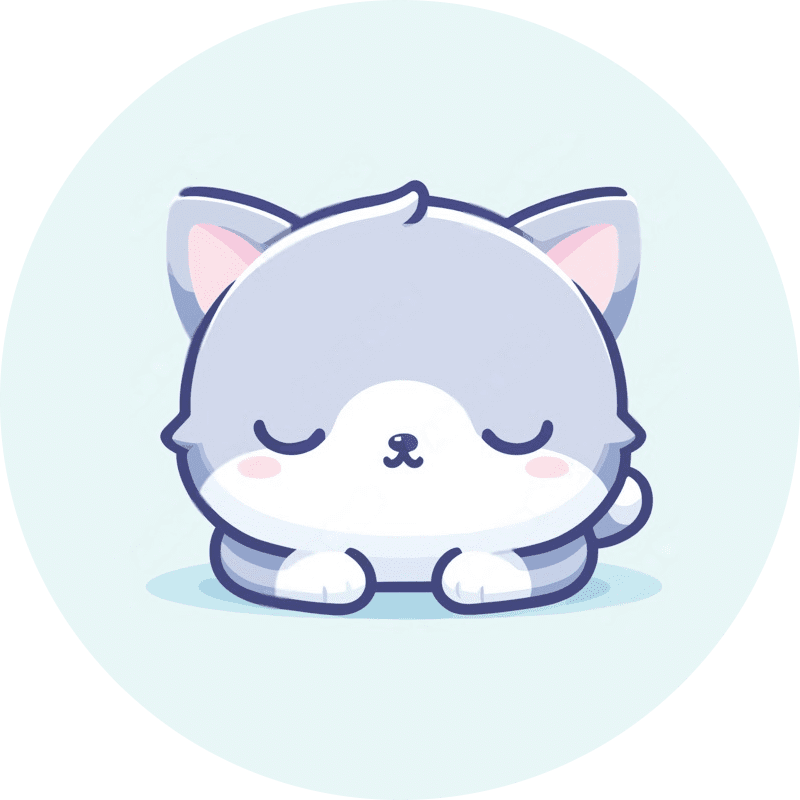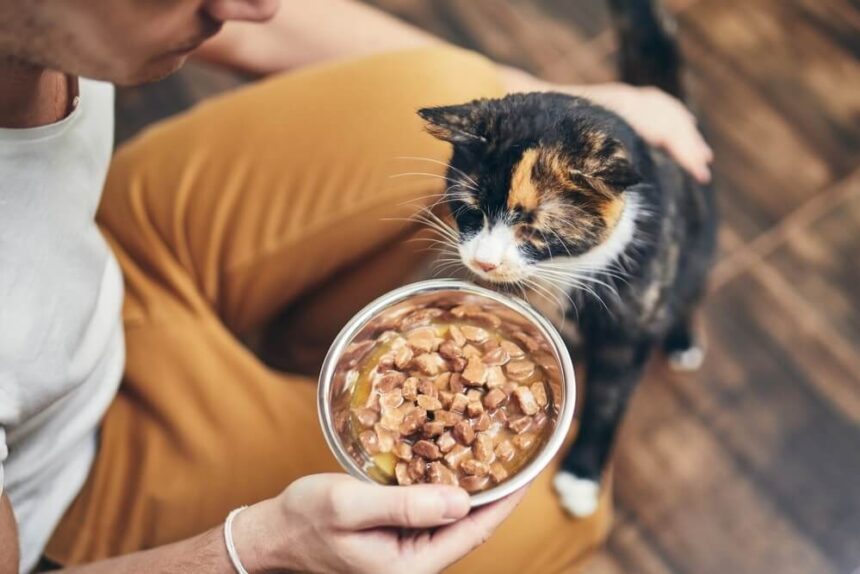Your furry companion means the world to you, so keeping them well-fed and happy is a top priority. But how many pounds of cat food per month should you be doling out to your feline friend to keep them purring? The answer depends on several factors, including your cat’s age, size, activity level, and overall health. Here is a helpful guide to determine about how many pounds of cat food your cat needs per month.
Feline Feeding Factors to Consider
When determining how much cat food to provide each month, there are several factors to take into account. These include your cat’s age, weight, activity level, and the type of food you’re feeding them. Each kitty is an individual, so finding the right balance is key. Let’s explore some guidelines to help you estimate your cat’s monthly food consumption. Meow-n’t we all want our feline friends to eat just right?
Age and Life Stage
Kittens have different nutritional requirements compared to adult cats or seniors. Growing kittens need more calories and nutrients to support their development. Adult cats have stable dietary needs, while older cats may have specific dietary considerations. Consider your cat’s life stage when calculating their food requirements.
Body Condition and Weight
A cat’s weight and body condition play a crucial role in determining their food intake. If your cat is maintaining a healthy weight, you can use their current weight as a starting point. If your cat is underweight or overweight, it’s important to consult with your veterinarian for guidance on appropriate portions and dietary adjustments.
Activity Level and Metabolism
Active, playful cats burn more calories than their couch-potato counterparts. If your cat is highly active or has a fast metabolism, they may require more food to meet their energy needs. On the other paw, less active cats may require fewer calories to maintain a healthy weight.
Type of Cat Food
The type of cat food you choose also influences the feeding quantities. Dry cat food tends to have higher calorie concentrations compared to wet cat food. Read the feeding guidelines provided by the cat food manufacturer and adjust the portions accordingly based on your cat’s specific needs.
Estimating Monthly Cat Food Amounts
Now that we’ve covered the key factors, let’s get down to the actual calculations. Keep in mind that these are general guidelines, and individual cat requirements may vary. Here’s a rough estimate to help you determine how many pounds of cat food you might need per month:
Calculate Daily Caloric Requirements
To start, determine your cat’s daily caloric needs based on their weight, age, and activity level. You can use online calculators or consult with your veterinarian for a more precise estimation.
Convert to Pounds
Once you have the daily caloric requirement, multiply it by the number of days in a month to get the monthly caloric requirement. Then, divide the monthly calories by the calorie content per pound of the cat food you’re feeding to estimate the necessary pounds of cat food per month.
Monitor and Adjust
Remember, these calculations provide a starting point. Monitor your cat’s weight and body condition regularly. If your cat is gaining or losing weight, adjust the portion sizes accordingly. It’s essential to find the right balance to keep your cat in tip-top shape.
Treats and Extras – Handle with Care!
While we’re discussing cat food quantities, it’s important to mention treats and extras. Treats should be given in moderation and accounted for in your cat’s overall caloric intake. Too many treats can lead to weight gain and nutritional imbalances. Stick to high-quality, cat-specific treats to keep your feline friend healthy and happy.
How Many Pounds Of Food Does A Cat Need?

Kitten Crunchies – Food for Growing Kittens
If you have a rambunctious little kitten scampering around, they will need more food to support their growth. Most vets recommend free-feeding kittens, keeping their bowl full of kitten food all the time. At around four months, you can start following the recommended amounts on the kitten food bag or can based on their expected adult size.
- Small breed kittens (under 10 lbs full grown) need 1/2 to 1 cup of kitten food per 5 pounds of body weight per day. So about 5 to 10 pounds of food per month.
- Large breed kittens (10 lbs and over full grown) need slightly less, around 1/2 cup per 5 pounds of body weight per day. Roughly 5 to 9 pounds of food per month.
Many kitten foods are formulated especially for growth, with more calories, protein, and certain nutrients kittens need. Be sure to feed your kitten based on their ideal adult weight, not necessarily how much they beg for! Free feeding a kitten can lead to obesity, even at a young age.
Food for Your Adult Cat
Once your cat reaches adulthood at around one year, it’s time to switch to an adult cat food and a regular feeding schedule. For most average adult cats, you should feed about 1/2 to 2/3 of a cup of quality dry food per 10 pounds of body weight per day, split into two meals.
- For a 10 pound cat, that comes out to around 5 pounds of dry cat food per month.
- A 15 pound cat would need around 8 pounds per month.
- A larger 20 pound cat would need 10-13 pounds of cat food per month.
These are just estimates—you know your cat best. If they seem hungry or are gaining/losing weight, make adjustments to keep your cat at an ideal weight and body condition score. Also ensure they have access to fresh, filtered water every day to stay hydrated.
Senior and Special Needs: Making Adjustments
Senior cats, age seven and older, will need a little more or less food depending on their activity level, condition and health. You may need to switch to a senior cat food, and watch for any behavior changes that could indicate an underlying health issue. Generally, feed about 5-10 pounds of food per month for an aging kitty.
- Cats with medical conditions like diabetes, kidney disease or hyperthyroidism will need a special diet. Follow the vet’s recommendations on any prescription food, medication or adjustments needed to keep the condition well-managed. Usually 3-8 pounds of rx food per month will do.
- Overweight or less active cats will require less food, around 1/3 to 1/2 cup per 10 lbs max per day. Pick a weight management formula and feed closer to 3-7 pounds per month to slim your cat down to a healthy weight.
- Highly active or working cats, such as outdoor cats, may need slightly more food. Up to 2/3 cup per 10 lbs of body weight each day, so 6-12 pounds per month. These cats also require more protein and certain nutrients to power their active lifestyle.
Here’s How Much To Feed A Cat
How Long Does A 16 Pound Bag Of Cat Food Last?
Let’s crunch some numbers to help you gauge how long a 16lb bag of dry cat food might last based on daily feeding amounts for your feline companions.
Assuming each cat consumes 1/2 cup of food per day, here’s an estimation of the bag’s duration:
➤ One Cat: If you have a single cat, the 16lb bag of dry cat food will last approximately 160 days. Meow-nificent!
➤ Two Cats: If you have two cats, each consuming 1/2 cup of food daily, the bag will last approximately 80 days. Double the cats, but still plenty of nourishment!
➤ Three Cats: With three hungry felines enjoying 1/2 cup of food daily, the bag of dry cat food will last around 53 days and 3 hours. Quite the dynamic trio!
Remember, these estimates are based on the assumption of each cat consuming 1/2 cup of food per day and a 16lb bag size. Keep in mind that individual cats may have different dietary needs, so it’s essential to monitor their weight and body condition and adjust the portions accordingly.
How Much Is Average Cat Food A Month?
When it comes to cat food, the cost can vary based on factors like brand, type (wet or dry), quality, and your cat’s size. So, how much should you budget for cat food each month? Let’s break it down.
On average, you can expect to spend around $20 to $60 per month on cat food. However, it’s important to note that these figures are general estimations and may vary depending on various factors.
Wet Food vs. Dry Food
If you choose to exclusively feed your cat wet food, be prepared for slightly higher costs compared to dry food. Wet cat food is typically sold in 5.5-ounce cans and can cost anywhere between $1 to $4 per can. Depending on your cat’s size and nutritional needs, they may require 2-4 cans per day.
On the other hand, dry cat food tends to be more affordable and comes in larger quantities. Prices for a 5-10 pound bag of dry cat food range from $10 to $30.
Customized Dietary Needs and Preferences
Remember, these cost estimates are average and may not account for specific dietary needs or preferences your cat may have. Some cats may require specialty diets, supplements, or treats due to health conditions or personal preferences. These additional expenses should be factored into your budget as well.
Keep an Eye on Fluffy’s Eating Habits
Calculating the right amount of cat food is a great start, but it’s equally important to monitor your cat’s eating habits. Here are a few tips to ensure your feline friend maintains a healthy relationship with food:
- Observe Regular Meal Times: Establish a consistent feeding schedule to help regulate your cat’s appetite and digestion.
- Avoid Overfeeding: Overindulging in treats or extra portions can lead to weight gain and potential health issues. Keep those treats in moderation!
- Stay Hydrated: Ensure your cat always has access to fresh water to prevent dehydration, especially if you’re feeding them dry cat food.
- Keep an Eye on Weight: Regularly monitor your cat’s weight to detect any sudden changes. Rapid weight loss or gain may indicate an underlying health problem.
Final Thoughts – Tailoring the Food Plan to Your Cat’s Needs
As a responsible cat parent, it’s essential to feed your fur baby an appropriate amount of food to maintain their health and well-being. While our guidelines can give you a general idea, remember that each cat is unique. Monitor their weight, body condition, and overall health regularly, and adjust their food portions as needed.
Determining exactly how many pounds of cat food your feline friend needs each month takes some consideration. In general, an average adult cat of normal activity level and health will do well on about 5 to 10 pounds of quality cat food per month. But by monitoring your cat’s weight, body condition score and overall health, and considering their life stage and activity level, you can pinpoint their ideal amount to keep them happy, active and always purring!
Don’t forget to consult with your veterinarian for personalized advice on your cat’s specific dietary needs. They can provide guidance on the ideal amount of cat food for your feline friend, ensuring they receive the purr-fect balance of nutrients and taste.
Here’s to happy, healthy cats and well-stocked pantries!



